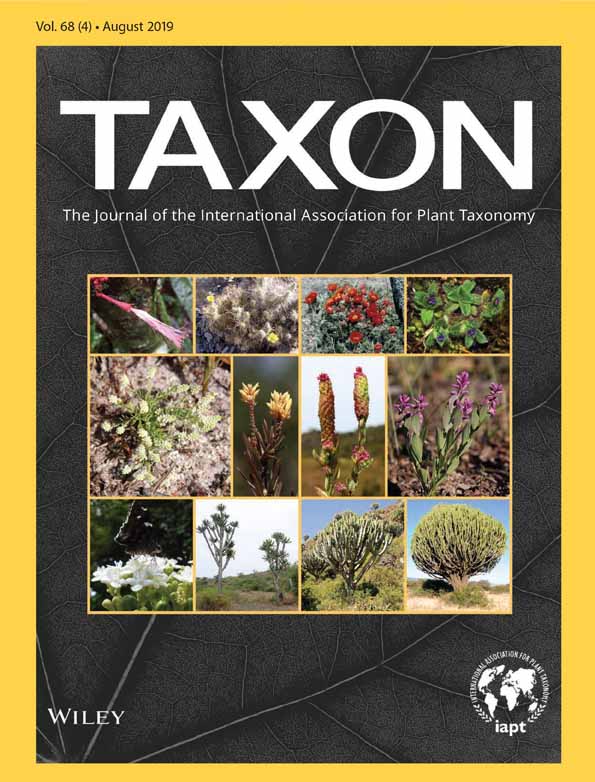Dr. Frederick Bruce Sampson (Bruce) (1937–2018)
Bruce Sampson (11 November 1937–11 May 2018) died after short illness while visiting New Plymouth (North Island, New Zealand), the city where he was born.
Bruce grew up as a single child on a dairy farm in Taranaki and was educated at New Plymouth Boys High School. Remarkably, this school produced two other accomplished New Zealand botanists, Bruce's classmate David Lloyd (Webb, 2007) and a few years later David Penny (http://www.massey.ac.nz/massey/about-massey/ news/article.cfm? mnarticle_uuid=FB8FD7F2-72A8-4181-A614-B9CD5D999D92). After finishing high school, Bruce went to Victoria University of Wellington (VUW) to study botany. He went then to Secondary Teachers College in Christchurch but worked at the same time on his M.Sc. thesis. Casual summer work as field assistant to A.P. (Tony) Druce on Mt. Taranaki and contact in Christchurch with Professor W.R. Philipson were early botanical influences.

Apart from periods of research and study leave, Bruce spent his whole career at VUW. He started his university studies there in 1956, completed his master's degree in 1961, attained his Ph.D. in 1967 while serving as a junior staff member, and was a Reader (Associate Professor) when he retired in 1998. Always an active and dedicated researcher, Bruce continued to publish as a Senior Associate, and by the time of his death he had authored and co-authored about 60 research articles, books, and book chapters, and was working on his fifth book.
Students remember him as an imposing and rather authoritarian figure at first year, who appeared to mellow as they matured, becoming a very encouraging, supportive, and compassionate teacher who nevertheless always had the highest of expectations.
Bruce's main research interest was the reproductive features of the angiosperm lineages that diverged before the specialisations of the Monocots and Eudicots, especially members of the orders Amborellales, Canellales and Laurales, and within those the families Monimiaceae, Trimeniaceae and Winteraceae. He focused on a short but critical period in the complex life cycle of flowering plants, from development of ovules and anthers, through sporogenesis and gametophyte development, to fertilization and development of the embryo. This is painstaking and detailed work requiring expertise in preparative techniques, observation, and interpretation. His early papers depended heavily on extensive sampling, fixation, serial sectioning and staining, and the use of light microscopy and drawing or photography to record and illustrate observations. Later, Bruce was an early adopter of electron microscopy, applying SEM in particular to the comparative morphology of pollen grains. He co-authored one of the first illustrated books using scanning electron microscopy to give students and the interested public a much clearer magnified view of the fine structure of plants (Troughton & Sampson, 1973).
Bruce Sampson's published work is thus primarily a series of detailed descriptive accounts of the sexual reproductive stages of early-divergent flowering plants, and it contributes valuable data and insights into the origin and nature of the Angiosperms. Although many of his study plants were from New Zealand or Australia, the questions driving the research were of international interest. Of particular importance are large bodies of work on Monimiaceae and Winteraceae, and significant recent collaborations applying his expertise with pollen to critical studies of key basal Angiosperms Amborella, Trimeniaceae, Lactoris, and Takhtajania. We think it's fair to say his legacy is appreciated more internationally than locally.
He also contributed significant reviews of microsporogenesis and pollen grain development (Sampson, 2000, 2010; Furness & al., 2002) and collaborated with Tammy Sage on a careful study of the timing of the self-incompatibility reaction in Pseudowintera, placing the timing of its action before division of the zygote and thus after double fertilization (Sage & Sampson, 2003).
Bruce was a perfectionist in everything he did, and this is particularly demonstrated in his scanning and transmission electron microscopy, where his skills and high expectations made him an excellent teacher. Bruce was also a keen and able photographer, and brought his photographic skills to his light and electron microscopy, producing valuable studies on the form, structure and developmental anatomy of the floral parts and pollen in the species he examined.
His appreciation of plant form and love of art inspired the book that is probably his best known to the New Zealand public: Early New Zealand botanical art (1985). He also contributed a series of accounts of native plants to the serial encyclopedia New Zealand nature heritage.
Bruce was an independent and highly self-motivated researcher, but he was also able to create opportunities for productive collaborations, both nationally and internationally, through correspondence, conferences, and study leaves, as well by taking an interest in scholars studying at School of Biological Sciences (SBS). He had the opportunity in 1969–70 to spend ten months as a Post-Doctoral Fellow in the Botany Department, University of California, Berkley (with Don Kaplan), and later nine months in 1976–7 as a Visiting Professor in Botany at Louisiana State University, Baton Rouge (with Shirley Tucker). He also spent three or four months at a time over three years at the University of New England, Armidale, Australia. Bruce's friendship and quality of research attracted several overseas academics to spend time at VUW with him (e.g., Peter Endress, James Doyle, Tammy Sage), which brought in a welcome exchange of ideas. He also visited some of the overseas colleagues with whom he collaborated, most recently in Thailand. After retirement he visited Thailand regularly, teaching at Nakhon Sawan Rajabhat University and collaborating on two books and a third one that is not yet completed.
His collaborations with others sometimes led him beyond his interest in early angiosperms and into other groups; he also got involved in Asteraceae pollen (Breitwieser & Sampson, 1997a,b) and Gesneriaceae (Palee & al., 2003). These experiences influenced him greatly and led to lifelong friendships.
He had a highly ordered mind and was meticulously organised, with a great command of the literature of his field. When posed a question from a student or colleague, Bruce could provide not only an answer, but after quickly consulting his phenomenal memory or catalogue could also produce a paper or two discussing the subject.
Bruce pursued active interests outside botany. Some (e.g., photography) contributed to his work and others (woodworking, botanical art) drew on his professional knowledge. He was also enthusiastic about quality cars and architecture and a lover of classical music and cats.
Bruce is survived by his wife Vivienne Sampson and his two sons John and Neil. The youngest of four grandchildren was born only a few weeks before he died.
Bruce's forthright nature could occasionally startle, but his delightful, witty sense of humour and great warmth and kindness, produced a combination that has endeared him to colleagues and students alike.




